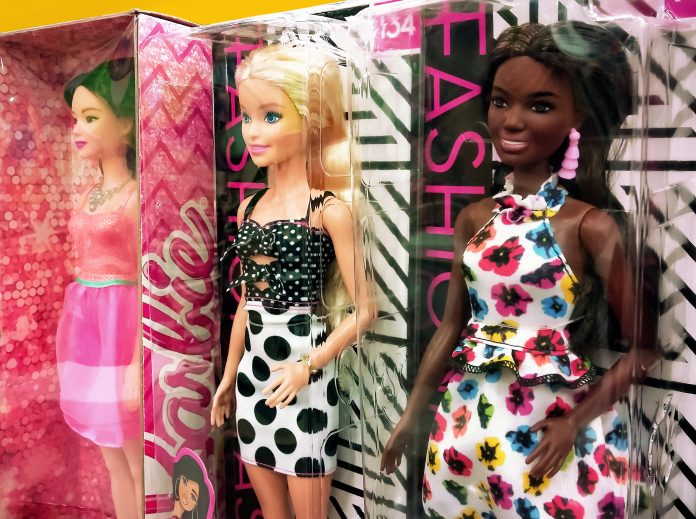When thinking about modern-day role models, Barbie might not be the first name that comes to mind. The first doll was released in 1959, and since then Barbie has repeatedly reinvented herself. Going from a beautiful ‘model’ who only cared about fashion and beauty, Barbie has now become a role model for young people all over the world.
While representing a limited vision of womanhood—being a skinny white woman with a ‘perfect’ body according to Western standards—Barbie also has a history of questionable phases. For example, in 1965, Barbie’s parent company, Mattel, released the Sleepover Barbie. This set included a scale permanently set to 110lbs (»50kg), and a weightloss book with only one instruction; ‘don’t eat’. Although nothing as controversial as this has been released in recent years, Barbie’s sales slowly dropped each year during the beginning of the 21st century. But a lot of things have happened with Barbie and Mattel in the past ten years to revitalise the brand.
To try to increase their sales again, while also becoming more progressive as a company, Mattel have diversified the way the dolls look. Barbie no longer ‘only’ looks like a skinny white girl with blonde hair. Since 1980, Barbie dolls come in a variety of skintones, with varying body shapes, and hair colours. This resulted in an increase in sales, but not enough for the company to be satisfied.
Her role model status has been growing since the early 1960s, as Barbie has shown young children (mostly girls) that they can do whatever they set their mind to. Children have watched her graduate university and conquer a variety of professions that are mostly male-dominated, such as an astronaut, a doctor, and a pilot. Although this has inspired children around the world to follow their dreams, the problem was that the character lacked dimension.
Following the success of her movie franchise, where she played various characters, in 2015 Barbie got her own YouTube channel. This way, the audience could get to know her more as a character or a friend rather than a doll. These continue to this day and include popular trends and challenges with Ken and her friends. But they also include sit-down talks, where she discusses important topics such as racism, gaslighting, mental health and bullying, in a way that is suitable for a younger audience.
In a vlog called ‘Finding Your Voice’, Barbie discusses the misogyny and gaslighting she and her friends experience. She brings up a moment when her ideas were ignored. When Ken, Barbie’s long-term boyfriend, repeated them to bring attention back to her, he gained the recognition for the ideas instead. Since the majority of Barbie’s audience consists of young girls, this video is a great way to prepare them for the injustices they may experience throughout their life. And thanks to Barbie’s tips, they learn what to do if they ever feel like their voices and ideas are being ignored.
In another video titled ‘Barbie and Nikki Discuss Racism’, Barbie invites her friend Nikki, a black doll, to discuss racism and what we can do to fight it. At first glance, it feels inappropriate to have Barbie, a white ‘teen’, discuss these issues. But it becomes clear that she uses her platform of over 9 million followers to let Nikki lead the discussion while she listens. Nikki not only talks about her own experiences and encounters with racism but also how important it is for white people to be allies in the fight for racial justice.
Although the video is just under three minutes long, Barbie and Nikki covered what racism is, how it is affecting people of colour, and the importance of standing together as allies to fight injustice in a suitable way for their young target audience. This video came out in October 2020, after months of protests and riots around the world had taken place to fight against racial injustice. By letting Nikki lead the conversation in the video, Barbie also shows people how it’s just as important to listen to others as it is to take action themselves.
In a statement, Mattel told CNN that Barbie is ‘‘championing gender equality to help close the racial injustice barrier girls face through the Dream Gap and this is one way the brand is addressing it’’. Mattel also mentioned how they hope these videos will help children understand these topics better.
By having a brand as big as Barbie create these kinds of important videos for children, they’re also creating a role model to turn to for guidance. Framing Barbie as this role model, not only helps Mattel increase sales, but it also creates a toy that’ll be a daily reminder for children to always be kind and to be brave enough to be themselves.
Words by Alice Sjoberg
This article was published as part of The Indiependent‘s May 2021 magazine edition.
Support The Indiependent
We’re trying to raise £200 a month to help cover our operational costs. This includes our ‘Writer of the Month’ awards, where we recognise the amazing work produced by our contributor team. If you’ve enjoyed reading our site, we’d really appreciate it if you could donate to The Indiependent. Whether you can give £1 or £10, you’d be making a huge difference to our small team.
